University Report: Lewin's Change Management Model and Application
VerifiedAdded on 2023/06/06
|5
|1205
|282
Report
AI Summary
This report provides an overview of Kurt Lewin's Change Management Model, a three-step process comprising unfreeze, change, and refreeze. The report explains the rationale behind the model's creation, emphasizing the need for stability in a dynamic environment. It details each stage, highlighting the importance of breaking resistance, facilitating change through communication, and solidifying new behaviors. The paper discusses the model's applicability, particularly in the context of organizations in Saudi Arabia, while also acknowledging its potential limitations, such as its rational approach and the need to consider human feelings. The report concludes by suggesting modifications to balance the model's application with sensitivity to human experiences, ensuring a more effective outcome. References to relevant literature are included to support the analysis.
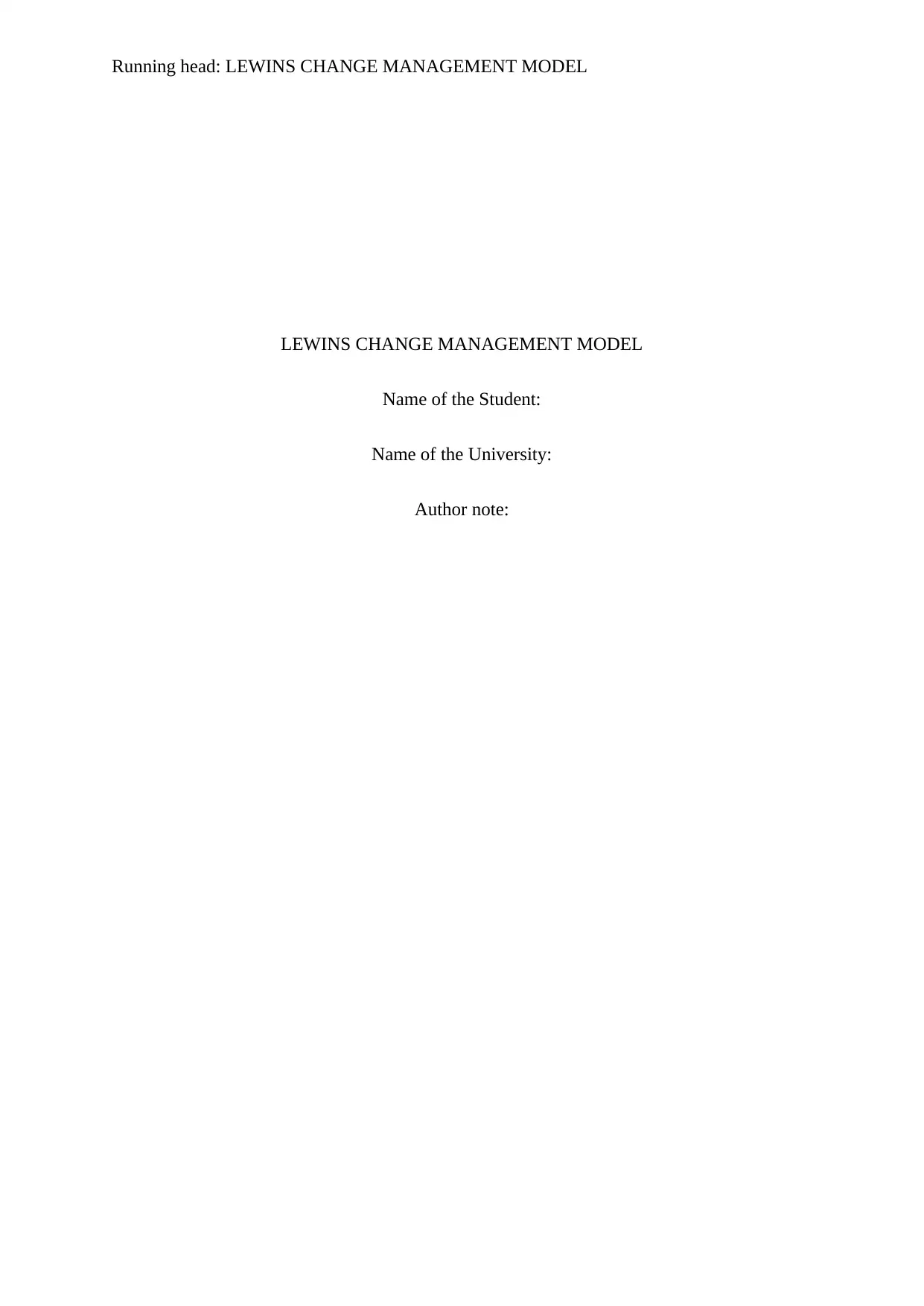
Running head: LEWINS CHANGE MANAGEMENT MODEL
LEWINS CHANGE MANAGEMENT MODEL
Name of the Student:
Name of the University:
Author note:
LEWINS CHANGE MANAGEMENT MODEL
Name of the Student:
Name of the University:
Author note:
Paraphrase This Document
Need a fresh take? Get an instant paraphrase of this document with our AI Paraphraser
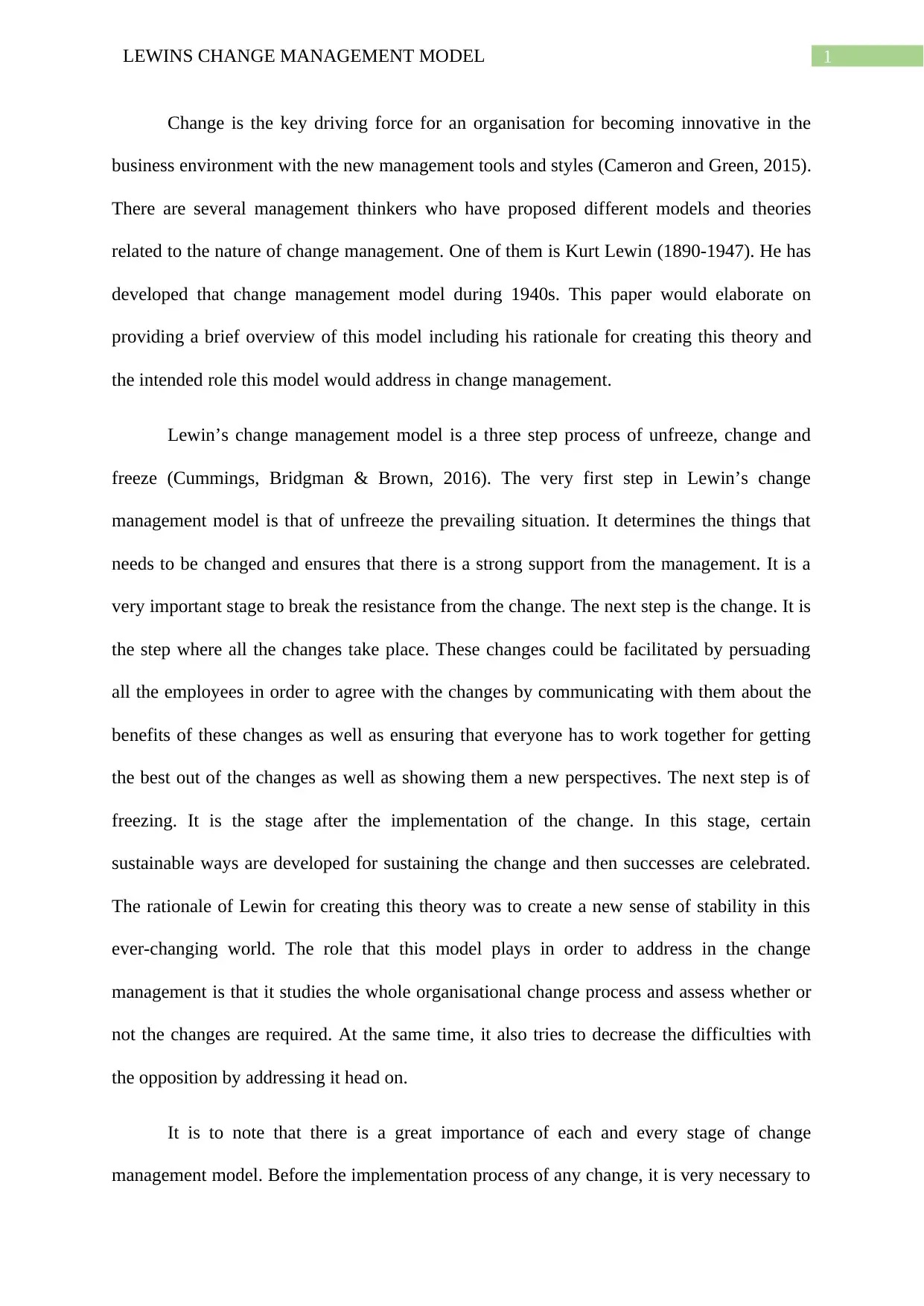
1LEWINS CHANGE MANAGEMENT MODEL
Change is the key driving force for an organisation for becoming innovative in the
business environment with the new management tools and styles (Cameron and Green, 2015).
There are several management thinkers who have proposed different models and theories
related to the nature of change management. One of them is Kurt Lewin (1890-1947). He has
developed that change management model during 1940s. This paper would elaborate on
providing a brief overview of this model including his rationale for creating this theory and
the intended role this model would address in change management.
Lewin’s change management model is a three step process of unfreeze, change and
freeze (Cummings, Bridgman & Brown, 2016). The very first step in Lewin’s change
management model is that of unfreeze the prevailing situation. It determines the things that
needs to be changed and ensures that there is a strong support from the management. It is a
very important stage to break the resistance from the change. The next step is the change. It is
the step where all the changes take place. These changes could be facilitated by persuading
all the employees in order to agree with the changes by communicating with them about the
benefits of these changes as well as ensuring that everyone has to work together for getting
the best out of the changes as well as showing them a new perspectives. The next step is of
freezing. It is the stage after the implementation of the change. In this stage, certain
sustainable ways are developed for sustaining the change and then successes are celebrated.
The rationale of Lewin for creating this theory was to create a new sense of stability in this
ever-changing world. The role that this model plays in order to address in the change
management is that it studies the whole organisational change process and assess whether or
not the changes are required. At the same time, it also tries to decrease the difficulties with
the opposition by addressing it head on.
It is to note that there is a great importance of each and every stage of change
management model. Before the implementation process of any change, it is very necessary to
Change is the key driving force for an organisation for becoming innovative in the
business environment with the new management tools and styles (Cameron and Green, 2015).
There are several management thinkers who have proposed different models and theories
related to the nature of change management. One of them is Kurt Lewin (1890-1947). He has
developed that change management model during 1940s. This paper would elaborate on
providing a brief overview of this model including his rationale for creating this theory and
the intended role this model would address in change management.
Lewin’s change management model is a three step process of unfreeze, change and
freeze (Cummings, Bridgman & Brown, 2016). The very first step in Lewin’s change
management model is that of unfreeze the prevailing situation. It determines the things that
needs to be changed and ensures that there is a strong support from the management. It is a
very important stage to break the resistance from the change. The next step is the change. It is
the step where all the changes take place. These changes could be facilitated by persuading
all the employees in order to agree with the changes by communicating with them about the
benefits of these changes as well as ensuring that everyone has to work together for getting
the best out of the changes as well as showing them a new perspectives. The next step is of
freezing. It is the stage after the implementation of the change. In this stage, certain
sustainable ways are developed for sustaining the change and then successes are celebrated.
The rationale of Lewin for creating this theory was to create a new sense of stability in this
ever-changing world. The role that this model plays in order to address in the change
management is that it studies the whole organisational change process and assess whether or
not the changes are required. At the same time, it also tries to decrease the difficulties with
the opposition by addressing it head on.
It is to note that there is a great importance of each and every stage of change
management model. Before the implementation process of any change, it is very necessary to
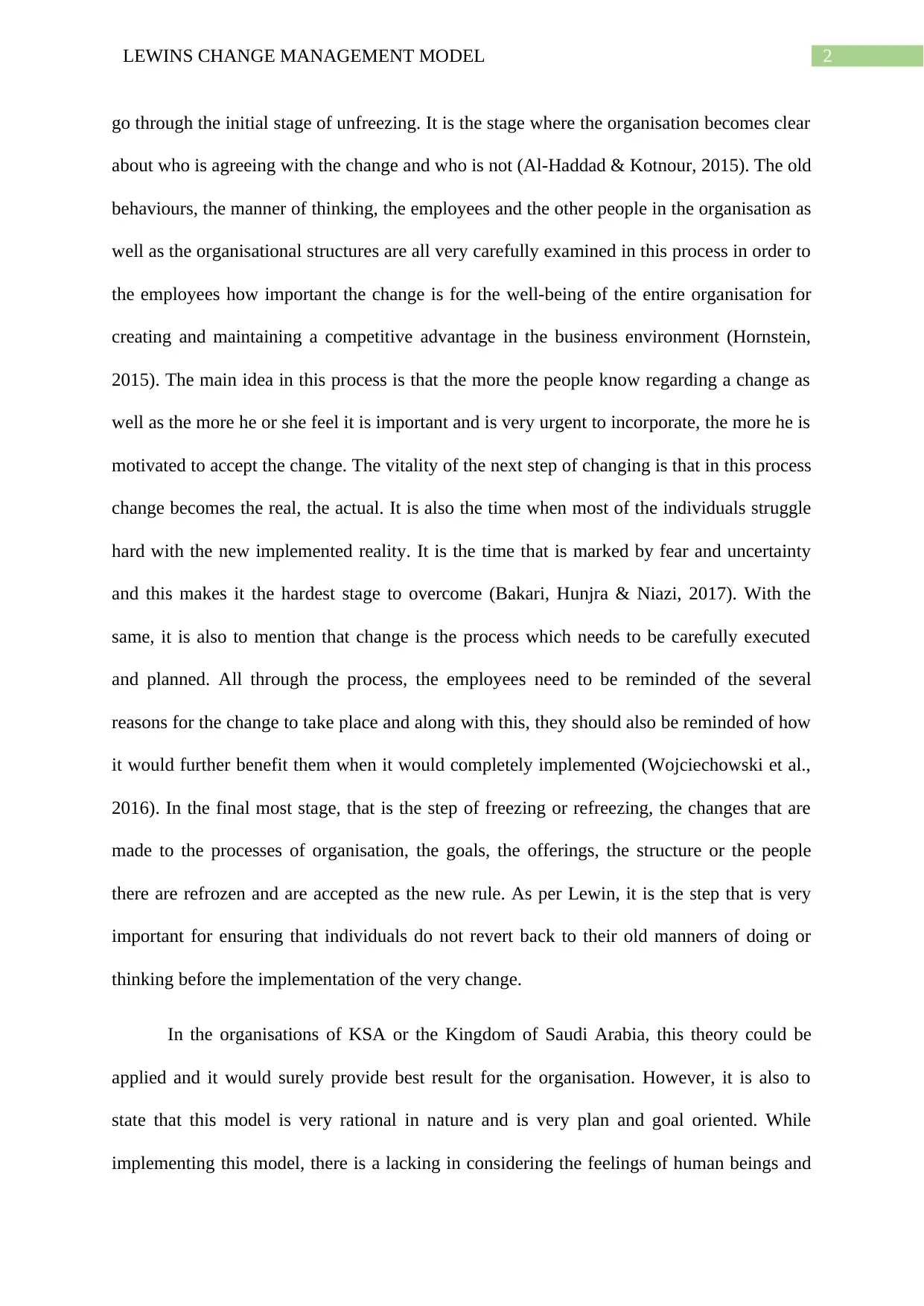
2LEWINS CHANGE MANAGEMENT MODEL
go through the initial stage of unfreezing. It is the stage where the organisation becomes clear
about who is agreeing with the change and who is not (Al-Haddad & Kotnour, 2015). The old
behaviours, the manner of thinking, the employees and the other people in the organisation as
well as the organisational structures are all very carefully examined in this process in order to
the employees how important the change is for the well-being of the entire organisation for
creating and maintaining a competitive advantage in the business environment (Hornstein,
2015). The main idea in this process is that the more the people know regarding a change as
well as the more he or she feel it is important and is very urgent to incorporate, the more he is
motivated to accept the change. The vitality of the next step of changing is that in this process
change becomes the real, the actual. It is also the time when most of the individuals struggle
hard with the new implemented reality. It is the time that is marked by fear and uncertainty
and this makes it the hardest stage to overcome (Bakari, Hunjra & Niazi, 2017). With the
same, it is also to mention that change is the process which needs to be carefully executed
and planned. All through the process, the employees need to be reminded of the several
reasons for the change to take place and along with this, they should also be reminded of how
it would further benefit them when it would completely implemented (Wojciechowski et al.,
2016). In the final most stage, that is the step of freezing or refreezing, the changes that are
made to the processes of organisation, the goals, the offerings, the structure or the people
there are refrozen and are accepted as the new rule. As per Lewin, it is the step that is very
important for ensuring that individuals do not revert back to their old manners of doing or
thinking before the implementation of the very change.
In the organisations of KSA or the Kingdom of Saudi Arabia, this theory could be
applied and it would surely provide best result for the organisation. However, it is also to
state that this model is very rational in nature and is very plan and goal oriented. While
implementing this model, there is a lacking in considering the feelings of human beings and
go through the initial stage of unfreezing. It is the stage where the organisation becomes clear
about who is agreeing with the change and who is not (Al-Haddad & Kotnour, 2015). The old
behaviours, the manner of thinking, the employees and the other people in the organisation as
well as the organisational structures are all very carefully examined in this process in order to
the employees how important the change is for the well-being of the entire organisation for
creating and maintaining a competitive advantage in the business environment (Hornstein,
2015). The main idea in this process is that the more the people know regarding a change as
well as the more he or she feel it is important and is very urgent to incorporate, the more he is
motivated to accept the change. The vitality of the next step of changing is that in this process
change becomes the real, the actual. It is also the time when most of the individuals struggle
hard with the new implemented reality. It is the time that is marked by fear and uncertainty
and this makes it the hardest stage to overcome (Bakari, Hunjra & Niazi, 2017). With the
same, it is also to mention that change is the process which needs to be carefully executed
and planned. All through the process, the employees need to be reminded of the several
reasons for the change to take place and along with this, they should also be reminded of how
it would further benefit them when it would completely implemented (Wojciechowski et al.,
2016). In the final most stage, that is the step of freezing or refreezing, the changes that are
made to the processes of organisation, the goals, the offerings, the structure or the people
there are refrozen and are accepted as the new rule. As per Lewin, it is the step that is very
important for ensuring that individuals do not revert back to their old manners of doing or
thinking before the implementation of the very change.
In the organisations of KSA or the Kingdom of Saudi Arabia, this theory could be
applied and it would surely provide best result for the organisation. However, it is also to
state that this model is very rational in nature and is very plan and goal oriented. While
implementing this model, there is a lacking in considering the feelings of human beings and
⊘ This is a preview!⊘
Do you want full access?
Subscribe today to unlock all pages.

Trusted by 1+ million students worldwide
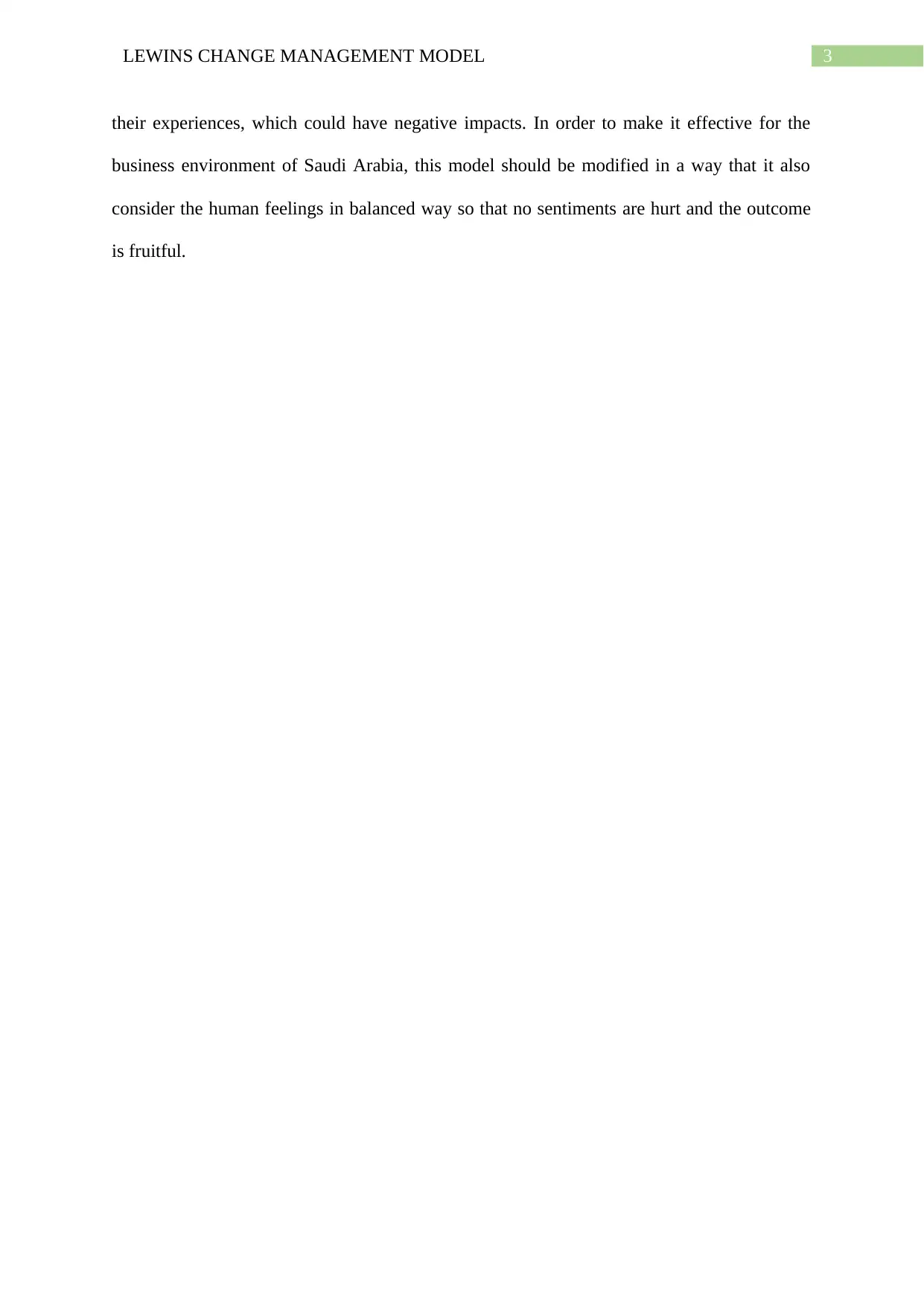
3LEWINS CHANGE MANAGEMENT MODEL
their experiences, which could have negative impacts. In order to make it effective for the
business environment of Saudi Arabia, this model should be modified in a way that it also
consider the human feelings in balanced way so that no sentiments are hurt and the outcome
is fruitful.
their experiences, which could have negative impacts. In order to make it effective for the
business environment of Saudi Arabia, this model should be modified in a way that it also
consider the human feelings in balanced way so that no sentiments are hurt and the outcome
is fruitful.
Paraphrase This Document
Need a fresh take? Get an instant paraphrase of this document with our AI Paraphraser
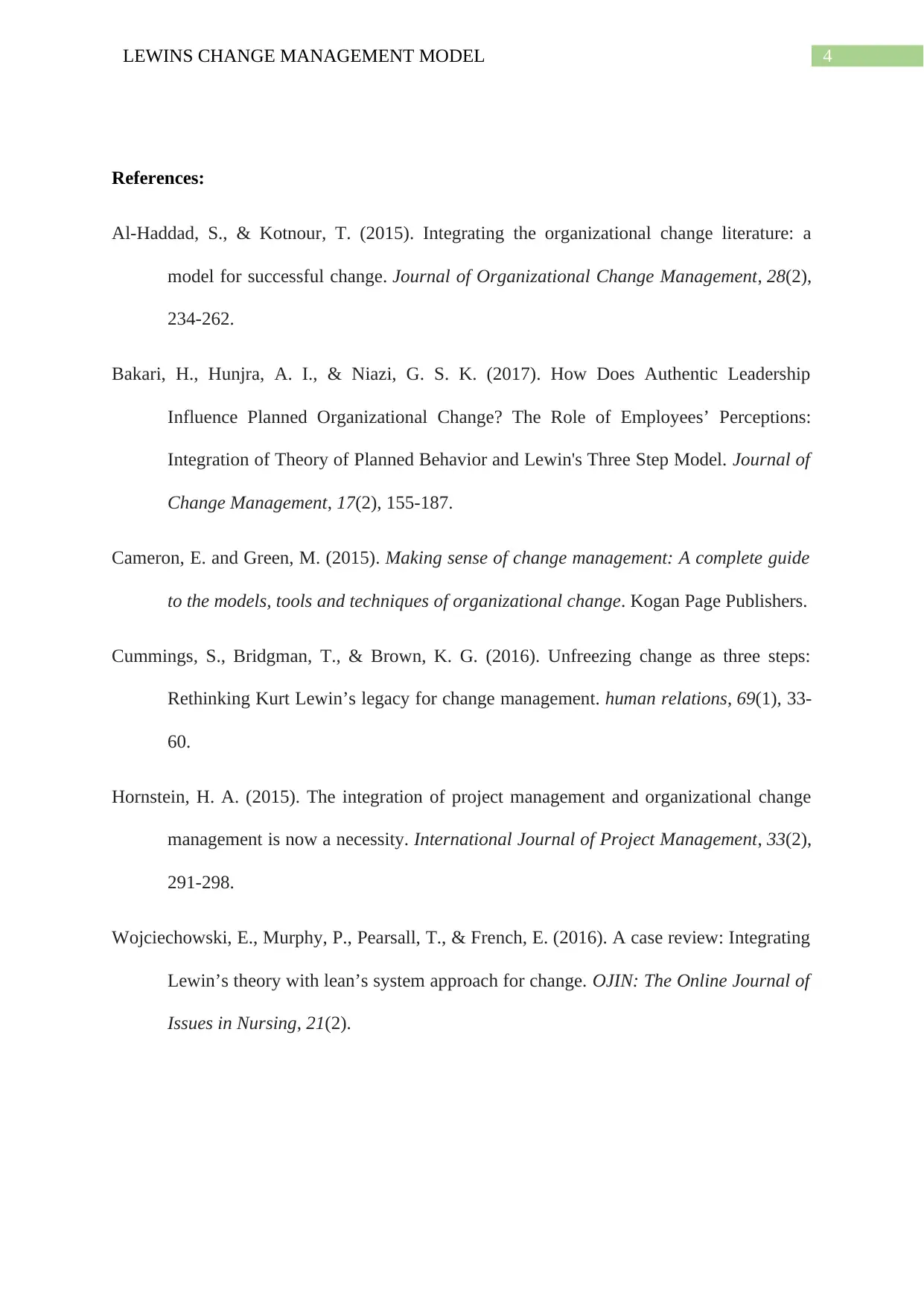
4LEWINS CHANGE MANAGEMENT MODEL
References:
Al-Haddad, S., & Kotnour, T. (2015). Integrating the organizational change literature: a
model for successful change. Journal of Organizational Change Management, 28(2),
234-262.
Bakari, H., Hunjra, A. I., & Niazi, G. S. K. (2017). How Does Authentic Leadership
Influence Planned Organizational Change? The Role of Employees’ Perceptions:
Integration of Theory of Planned Behavior and Lewin's Three Step Model. Journal of
Change Management, 17(2), 155-187.
Cameron, E. and Green, M. (2015). Making sense of change management: A complete guide
to the models, tools and techniques of organizational change. Kogan Page Publishers.
Cummings, S., Bridgman, T., & Brown, K. G. (2016). Unfreezing change as three steps:
Rethinking Kurt Lewin’s legacy for change management. human relations, 69(1), 33-
60.
Hornstein, H. A. (2015). The integration of project management and organizational change
management is now a necessity. International Journal of Project Management, 33(2),
291-298.
Wojciechowski, E., Murphy, P., Pearsall, T., & French, E. (2016). A case review: Integrating
Lewin’s theory with lean’s system approach for change. OJIN: The Online Journal of
Issues in Nursing, 21(2).
References:
Al-Haddad, S., & Kotnour, T. (2015). Integrating the organizational change literature: a
model for successful change. Journal of Organizational Change Management, 28(2),
234-262.
Bakari, H., Hunjra, A. I., & Niazi, G. S. K. (2017). How Does Authentic Leadership
Influence Planned Organizational Change? The Role of Employees’ Perceptions:
Integration of Theory of Planned Behavior and Lewin's Three Step Model. Journal of
Change Management, 17(2), 155-187.
Cameron, E. and Green, M. (2015). Making sense of change management: A complete guide
to the models, tools and techniques of organizational change. Kogan Page Publishers.
Cummings, S., Bridgman, T., & Brown, K. G. (2016). Unfreezing change as three steps:
Rethinking Kurt Lewin’s legacy for change management. human relations, 69(1), 33-
60.
Hornstein, H. A. (2015). The integration of project management and organizational change
management is now a necessity. International Journal of Project Management, 33(2),
291-298.
Wojciechowski, E., Murphy, P., Pearsall, T., & French, E. (2016). A case review: Integrating
Lewin’s theory with lean’s system approach for change. OJIN: The Online Journal of
Issues in Nursing, 21(2).
1 out of 5
Related Documents
Your All-in-One AI-Powered Toolkit for Academic Success.
+13062052269
info@desklib.com
Available 24*7 on WhatsApp / Email
![[object Object]](/_next/static/media/star-bottom.7253800d.svg)
Unlock your academic potential
Copyright © 2020–2025 A2Z Services. All Rights Reserved. Developed and managed by ZUCOL.




